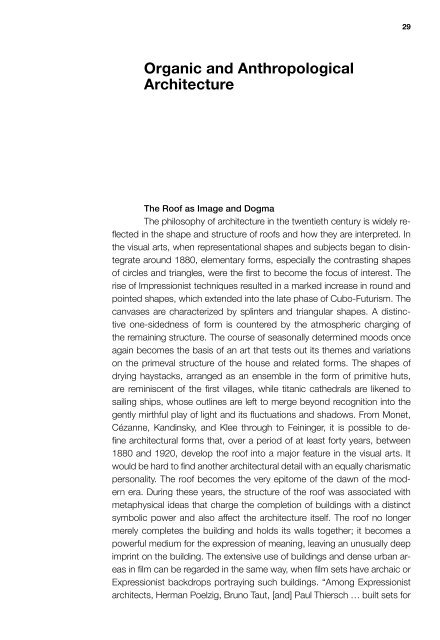Neuroarchitecture
978-3-86859-479-9 https://www.jovis.de/de/buecher/product/neuroarchitecture.html
978-3-86859-479-9
https://www.jovis.de/de/buecher/product/neuroarchitecture.html
Create successful ePaper yourself
Turn your PDF publications into a flip-book with our unique Google optimized e-Paper software.
29<br />
Organic and Anthropological<br />
Architecture<br />
The Roof as Image and Dogma<br />
The philosophy of architecture in the twentieth century is widely reflected<br />
in the shape and structure of roofs and how they are interpreted. In<br />
the visual arts, when representational shapes and subjects began to disintegrate<br />
around 1880, elementary forms, especially the contrasting shapes<br />
of circles and triangles, were the first to become the focus of interest. The<br />
rise of Impressionist techniques resulted in a marked increase in round and<br />
pointed shapes, which extended into the late phase of Cubo-Futurism. The<br />
canvases are characterized by splinters and triangular shapes. A distinctive<br />
one-sidedness of form is countered by the atmospheric charging of<br />
the remaining structure. The course of seasonally determined moods once<br />
again becomes the basis of an art that tests out its themes and variations<br />
on the primeval structure of the house and related forms. The shapes of<br />
drying haystacks, arranged as an ensemble in the form of primitive huts,<br />
are reminiscent of the first villages, while titanic cathedrals are likened to<br />
sailing ships, whose outlines are left to merge beyond recognition into the<br />
gently mirthful play of light and its fluctuations and shadows. From Monet,<br />
Cézanne, Kandinsky, and Klee through to Feininger, it is possible to define<br />
architectural forms that, over a period of at least forty years, between<br />
1880 and 1920, develop the roof into a major feature in the visual arts. It<br />
would be hard to find another architectural detail with an equally charismatic<br />
personality. The roof becomes the very epitome of the dawn of the modern<br />
era. During these years, the structure of the roof was associated with<br />
metaphysical ideas that charge the completion of buildings with a distinct<br />
symbolic power and also affect the architecture itself. The roof no longer<br />
merely completes the building and holds its walls together; it becomes a<br />
powerful medium for the expression of meaning, leaving an unusually deep<br />
imprint on the building. The extensive use of buildings and dense urban areas<br />
in film can be regarded in the same way, when film sets have archaic or<br />
Expressionist backdrops portraying such buildings. “Among Expressionist<br />
architects, Herman Poelzig, Bruno Taut, [and] Paul Thiersch … built sets for


















